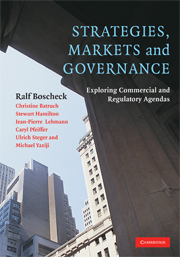Book contents
- Frontmatter
- Contents
- List of Figures, Boxes and Tables
- Acknowledgments
- Preface
- Notes on Contributors
- Part I Introduction and overview
- Part II Firm-level
- Part III Industry-level
- 9 How the clean air interstate rule will affect investment and management decisions in the US electricity sector
- 10 EU water infrastructure management: National regulations, EU framework directives but no model to follow
- 11 Market-testing healthcare: Managed care, market evolution and the search for regulatory principles
- 12 On governing natural resources
- Part IV Country/International level
- Part V An observation in closing
- Index
9 - How the clean air interstate rule will affect investment and management decisions in the US electricity sector
Published online by Cambridge University Press: 06 July 2010
- Frontmatter
- Contents
- List of Figures, Boxes and Tables
- Acknowledgments
- Preface
- Notes on Contributors
- Part I Introduction and overview
- Part II Firm-level
- Part III Industry-level
- 9 How the clean air interstate rule will affect investment and management decisions in the US electricity sector
- 10 EU water infrastructure management: National regulations, EU framework directives but no model to follow
- 11 Market-testing healthcare: Managed care, market evolution and the search for regulatory principles
- 12 On governing natural resources
- Part IV Country/International level
- Part V An observation in closing
- Index
Summary
Introduction Overview of the Clean Air Act Interstate Rule (CAIR)
The Clean Air Act (CAA) of 1970 (amended in 1977 and in 1990) is the US framework for establishing National Ambient Air Quality Standards (NAAQS) to protect public health and welfare and to control harmful emissions from sources of air pollution to achieve those standards. The Clean Air Act is administered by a federal agency, the US Environmental Protection Agency (EPA).
In July 1997, the EPA revised the National Ambient Air Quality Standards for ozone and particulate matter. The new NAAQS for ozone changed the existing standard from one that measures ozone concentrations over a one-hour period to one that measures over an eight-hour period, and tightened the concentration of the pollutant from 120 parts per billion (ppb) to 80 ppb. For particulate matter less than 2.5 microns in diameter (PM2.5), the EPA identified NOx from fossil-fired power plants as a major contributor to ozone pollution, and acid aerosols (nitrogen oxides (NOx) and sulfur-dioxide (SO2)) from fossil-fired power plants as fine particulates likely to be subject to additional controls.
The EPA designated eight-hour ozone and PM2.5 nonattainment areas (counties) based on ground-level monitoring of pollutant levels. If an area's monitored concentration of a pollutant exceeds the standard, then EPA categorizes that as nonattainment. Each state with a nonattainment area(s) then submits a plan for attainment (a State Implementation Plan or SIP).
- Type
- Chapter
- Information
- Strategies, Markets and GovernanceExploring Commercial and Regulatory Agendas, pp. 151 - 165Publisher: Cambridge University PressPrint publication year: 2008



